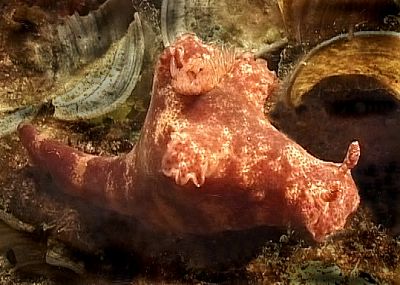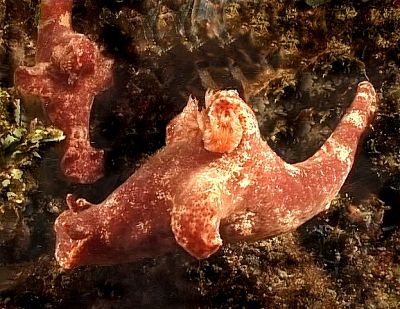Ceratosoma gracillimum from the Solomon Ids
November 29, 2001
From: Bruce Potter


Bill,
I found three of these Ceratosoma last night (19 November) on a dive site just on the outskirts of Honiara, Solomon Islands.
They were at about 12 meters, and the largest of the three would have been about 10mm long. Is this Ceratasoma gracillimum?
What interests me is that I have been diving in Solomon Islands for 12 years, and the past three on this particular site nearly every week, and I have never seen this Ceratasoma before, then I suddenly find three, all together. How did they find each other, or is it possible that they all hatched out at the same time, and have stayed together all the time?
Regards
Bruce Potter.
bruce.potter@adventist.org.sb
Potter, B., 2001 (Nov 29) Ceratosoma gracillimum from the Solomon Ids. [Message in] Sea Slug Forum. Australian Museum, Sydney. Available from http://www.seaslugforum.net/find/5706Dear Bruce,
Yes this is C. gracillimum. Why are they together and why haven't you seen it before? We still have much to learn about nudibranch population dynamics. While it has been possible to study some temperate water species in considerable detail, because they have fairly large 'permanent' populations, this has not proved so easy with species which are not so common, or feed on animals which are themselves fairly sparsely distributed, which is the case with many tropical animals.
If you consider the lottery they participate in. If their egg mass survives, they hatch out as planktonic larvae and after some days or weeks drifting in the plankton, they then have to find the right sponge (or other appropriate food) to settle on and grow to adulthood. Keep in mind that the sponge has has also gone through a similar planktonic larval stage. This certainly explains why a species can suddenly arrive at a particular spot, such as your dive site, even though it has been absent from there for many years. Apparently this year the sponge larvae settled, and a while later the nudibranch larvae drifted past and sensed its presence. How come three Ceratosoma settled together? I guess that is one of life's little mysteries. I find it difficult to believe that a group of C. gracillimum larvae stuck together during their planktonic life, but until someone devises a way to study this, it must remain a possibility. However it happened, clearly a number of larvae sensed an appropriate sponge colony, or perhaps a 'garden' of many sponges of the same species, and settles out of the plankton. Again there are very few long-term studies of tropical species but the little evidence we have suggests they stay near their food colonies, which would explain why you found three together. This is just conjecture. It would be nice to have some more long-term studies of tropical species, but such work is note easy.
Best wishes,
Bill Rudman
Related messages
-
Ceratosoma gracillimum from Alor, Indonesia
From: Francois Zylberman, April 24, 2008 -
Ceratosoma gracillimum feeding?
From: Kamal El Tawil, April 2, 2008 -
Ceratosoma gracillimum from Singapore
From: Lior Harari, September 3, 2007 -
Possible juvenile Ceratosoma?
From: Charles Raabe, August 20, 2007 -
Re: Ceratosoma gracillimum feeding? from Lembeh
From: Ken Tucker, July 23, 2007 -
Colour variations of Ceratosoma trilobatum?
From: Mike Krampf, December 22, 2006 -
Ceratosoma gracillimum? from Komodo Ids
From: Teresa Zubi, December 11, 2003 -
Ceratosoma gracillimum from north Sulawesi
From: Francis & Pirjo Pellet, December 10, 2003 -
Ceratosoma gracillimum from Japan
From: Atsushi Ono , September 19, 2000
